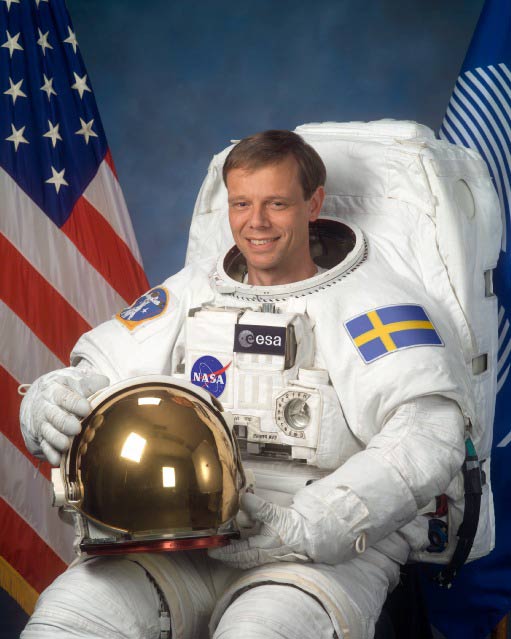ESA Astronaut Biography: Christer Fuglesang

NAME:Christer Fuglesang
ESA ASTRONAUT
PERSONALDATA: Born March18, 1957 in Stockholm, Sweden. Married to the former Elisabeth Walldie. Theyhave three children. He enjoys sports, sailing, skiing, frisbee, games andreading.
EDUCATION: Graduated from Bromma Gymnasium,Stockholm, Sweden, in 1975; received a master of science degree in EngineeringPhysics from the Royal Institute of Technology (KTH), Stockholm, Sweden, in1981; received a doctorate in Experimental Particle Physics from the Universityof Stockholm in 1987. He became a Docent in Particle Physics at the Universityof Stockholm in 1991.
SPECIALHONORS: Awarded anHonorary Doctorate from Umea University, Sweden, in October 1999.
EXPERIENCE: As a graduate student, Fuglesang workedat CERN (European Research Center on Particle Physics) in Geneva on the UA5experiment, which studied proton-antiproton collisions.
In 1988 hebecame a Fellow of CERN, where he worked on the CPLEAR experiment studying thesubtle CP-violation of Kaon-particles. After a year he became a Senior Fellowand head of the particle identification subdetector. In November 1990,Fuglesang obtained a position at the Manne Siegbahn Institute of Physics,Stockholm, but remained stationed at CERN for another year working towards thenew large hadron collider project. Since 1980, when stationed in Sweden,Fuglesang taught mathematics at the Royal Institute of Technology.
In May1992, Fuglesang was selected to join the Astronaut Corps of the EuropeanSpace Agency (ESA) based at the European Astronaut Centre (EAC) in Cologne,Germany. In 1992 he attended an introductory training programme at EAC and afour-week training program at TsPK (Cosmonauts Training Center) in Star City,Russia, with a view to future ESA-Russian collaboration on the MirSpace Station. In July 1993, he completed the basic training course at EAC.
Breaking space news, the latest updates on rocket launches, skywatching events and more!
In May1993, Fuglesang and fellow ESA astronaut, ThomasReiter, were selected for the Euromir 95 mission and commenced training atTsPK (Moscow) in preparation for their onboard engineer tasks, extra-vehicularactivities (spacewalks) and operation of the Soyuz spacecraft. The Euromir 95experiment training was organized and mainly carried out at EAC.
On 17 March1995, he was selected as a member of Crew 2, the backup crew for the Euromir95 mission, joining Genadi Manakov and Pavel Vinogradov. During themission, which lasted 179 days, Fuglesang was the prime crew interfacecoordinator. From the Russian Mission Control Center (TsUP) in Kaliningrad, hewas the main contact with Reiter, on Mir, and acted as coordinator between Mirand the Euromir 95 Payloads Operations Control Center, located inOberpfaffenhofen, Germany, and project management.
BetweenMarch and June 1996, he underwent specialized training in TsPK on Soyuzoperations for de-docking, atmospheric re-entry and landing.
NASAEXPERIENCE: ChristerFuglesang entered the Mission Specialist Class at NASA Johnson Space Center, Houston, inAugust 1996, and qualified for flight assignment as a mission specialist inApril 1998. From May to October 1998, he resumed training at TsPK on Soyuz-TMspacecraft operations for de-docking, atmospheric re-entry and landing. He wasawarded the Russian 'Soyuz Return Commander' certificate, which qualifies himto command a three-person Soyuz capsule on its return from space.
In October1998 he returned to NASA-JSC and was assigned technical duties in the AstronautOffice Station Operations System Branch on Russian Transfer Vehicles (i.e.Soyuz and Progress). Later he worked as prime Increment Crew Support Astronautfor the Expedition Corps of the 2ndInternational Space Station increment crew. Christer Fuglesang hascontinued with some scientific work and was involved with the SilEye experimentwhich investigated light flashes in astronaut's eyes on Mir between 1995 and1999. This work is continuing on the International Space Station(ISS) with the Alteino and ALTEA apparatuses. The former is on ISS since 2002,the latter is planned to fly to the ISS in 2005. He has also initiated theDESIRE project to simulate and estimate the radiation environment inside ISS.
ChristerFuglesang is a member of ESA's European Astronaut Corps, whose home base is theEuropean Astronaut Center located in Cologne, Germany. He is assignedcollateral duties in the NASA-JSC Astronaut Office and most recently wasassigned to the ISS Payload Branch. Currently, he is assigned to the crew of STS-116,an assembly and crew-rotation mission to the International SpaceStation.
Lastupdated: January 2005
- Mission Discovery: The ISS Rewiring Job of NASA's STS-116
- Complete Space Shuttle Mission Coverage
- The Great Space Quiz: Space Shuttle Countdown
- All About Astronauts

The National Aeronautics and Space Administration (NASA) is the U.S. government agency in charge of the civilian space program as well as aeronautics and aerospace research. Founded in 1958, NASA is a civilian space agency aimed at exploring the universe with space telescopes, satellites, robotic spacecraft, astronauts and more. The space agency has 10 major centers based across the U.S. and launches robotic and crewed missions from the Kennedy Space Center in Cape Canaveral Florida. Its astronaut corps is based at the Johnson Space Center in Houston. To follow NASA's latest mission, follow the space agency on Twitter or any other social channel, visit: nasa.gov.
